Nige learned to cook in immigration detention – now he’s teaching Australians his recipes
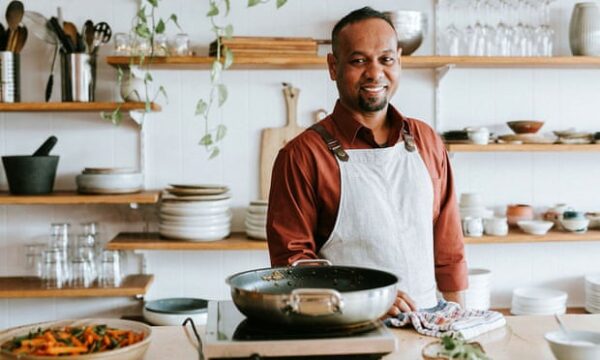
Source:-theguardian
Launched in response to the pandemic, a national meal kit service shares the stories and cuisines from chefs of refugee and asylum seeker backgrounds
“My belly is laughing when I try some curry,” says Nigethan ‘Nige’ Sithirasegaram into one of the three cameras pointed at him. “Even the smell makes me happy.”
It’s a gloomy Melbourne morning but Sithirasegaram is positively beaming. Perched in front of a bright yellow backdrop at Free to Feed – a social enterprise and cooking school in Northcote – he’s telling stories for the suite of short films that will accompany a meal kit he’s releasing nationally on 17 November.
Before the pandemic, Free to Feed ran sell-out cooking classes that enabled customers to learn how to make dishes like Assyrian Mutabal Kousa (fried zucchini with a yoghurt tahini dressing) and Persian Zereshk Polo Ba Morgh (jewelled rice with saffron-braised chicken) under the supervision of chefs from refugee and asylum seeker backgrounds. Chefs like Sithirasegaram, a third-generation fisherman from Sri Lanka who taught himself how to cook in the six years he spent in Australian detention or, as he refers to it, “my bad time”.
In 2009, Sithirasegaram fled his home of Trincomalee and Sri Lanka’s civil war for his own safety, and to find a more peaceful life for his wife and son. At the time, Tamil men were at particular risk of being forcibly disappeared – according to Amnesty International, Sri Lanka has one of the highest rates of disappearances in the world.
After a harrowing stretch on Christmas Island, Sithirasegaram was transferred to Villawood Immigration Detention Centre in Sydney, then to Melbourne Immigration Transit Accommodation (Mita). “I had a very stressful time in detention,” he says. “I never thought I’d survive.”
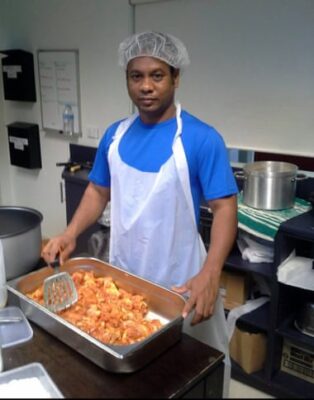
Permitted to one (supervised) grocery shop a week at Villawood and Mita, Sithirasegaram would call his wife and ask her to teach him the recipes she used to cook back home. “I would think about my wife’s food, my mum’s food,” he says. “Every day, I would cook and cook and cook, and keep learning. That would make me happy.”
Sithirasegaram was granted a bridging visa and released from detention in 2015. He honed his cooking skills at Tamil Feasts, a tri-weekly Sri Lankan pop-up food event that saw him making curries, sambal, chutney and dahl alongside three friends he met in detention.
Free to Feed co-founders Loretta and Daniel Bolotin began the enterprise in 2016 to help create meaningful employment opportunities for refugees, people seeking asylum and new migrants. But when Covid-19 made their in-person events impossible, they had to find other ways to support their 14 cooks, leaders and hosts.
As well as a meal delivery service and Zoom cooking classes, one of those other ways became ‘All Together Now’, a DIY meal kit and cultural exchange in a box. And the result, according to both the Bolotins, is a surprisingly vivid distillation of their mission statement.
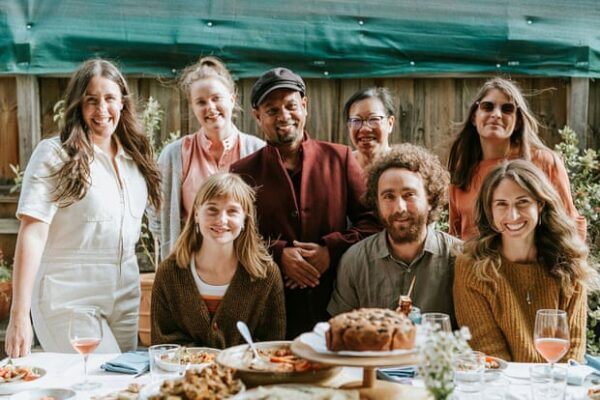
The first edition of All Together Now (the name itself a suggestion for how the meals ought to be prepared and enjoyed), was released in August and featured personal recipes and stories from Iranian chef and refugee Mahshid Babzartabi. “It gives me a feeling I’m invited all over Australia,” says Babzartabi of the success of her edition of All Together Now, “that despite years of living in limbo, we are welcomed by Australians”.
Sithirasegaram learned how to make curry powder by watching his mother and auntie when he was a child. In his kit, he demonstrates different variations of the blend, and talks about how the recipe varies slightly depending on how he’s feeling. “It’s like a hug,” he says.
Each of the 11 recipes on Sithirasegaram’s All Together Now menu has its own story, from his auntie’s chai butter cake to his wife’s coconut fried squid – one of the dishes he learned to cook in detention with her over-the-phone tutelage. “My wife had a big smile and I had a big smile,” he says of the first time he nailed the recipe (after a couple of botched attempts).
Sithirasegaram – who aspires to one day start his own food truck – now lives in Melbourne’s north, and has been separated from his family for over a decade. Just three-years-old when he left, his son has turned 14 – “a man now” says Sithirasegaram. It still remains unsafe for him to return to Sri Lanka, and Sithirasegaram must wait to be granted the appropriate visa class before he can bring his family to Australia.
Sithirasegaram’s wife, who he remains in touch with daily, can hardly believe what’s become of her husband. “She gets a little bit jealous because I’m cooking more than her,” he says with a chuckle. “She says, ‘How do you know so much about cooking now?’ I just smile: ‘This is my job’, I say. ‘I’m a professional now. And when you come to Australia, I’ll cook for you!’”
Nige’s beetroot sambal
Serves 4- 6
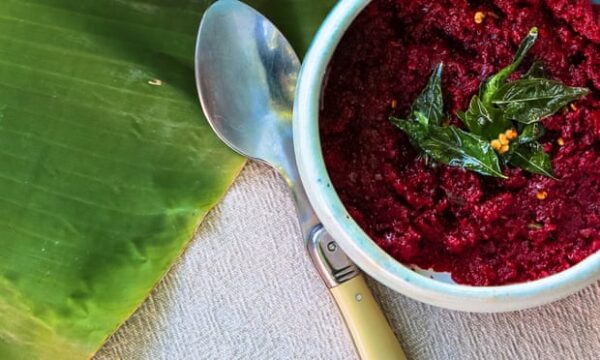
2 medium-sized beetroots, 1.5cm dice
1 tomato, roughly diced
1 red onion 1.5cm dice
1 clove garlic, peeled
1-2 dried red chilis (adjust amount to suit how hot you like your sambal)
1⁄4 cup cashew nuts
Juice of 1⁄2 lemon
Salt
1 tsp black mustard seeds
1 tsp fennel seeds
1 stalk fresh curry leaves, removed from stalk
40ml coconut oil (can substitute with vegetable oil)
Special equipment
Food processor or stick blender
Heat oil in a pan, add chilis and cook for a minute then, add beetroot, onion, garlic, tomato and stir occasionally until onion has browned (about five minutes).
In the meantime soak the cashews in boiling water and set aside for five minutes, then drain.
Place the cashews and beetroot mixture into the bowl of the food processor and blend until very smooth. Add lemon juice and season with salt, place in serving dish.
Place a small frypan on the stove to heat, add mustard and fennel seeds and cook until the mustard seeds pop. Add the curry leaves, stir, then remove from heat. Garnish the beetroot sambal with the mustard and fennel seeds and curry leaves.
Nige’s yoghurt rice
Serves 4 -6
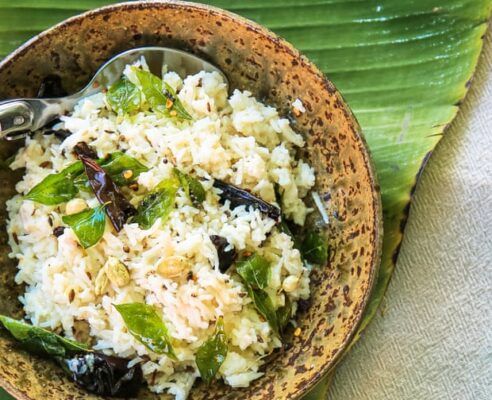
2 cups basmati rice
1 tbsp black mustard seed
1 tbsp fennel seed
4 cardamon pods
2 stalks curry leaf, stripped
4 dried chilli
2 tbsp coconut oil
1⁄2 brown onion, finely chopped
1 cup yoghurt (use coconut yoghurt for a dairy alternative)
Wash the rice two to three times and drain.
Cook the rice in a rice cooker or a saucepan using the absorption method.*
Heat coconut oil until hot and fry mustard seed, fennel seed, cardamom pods, curry leaves, chilis and onion until the mustard seeds pop and the onion has browned.
Add 1⁄4 cup water, stir and reduce heat to the lowest point – the water stops the cooking process, so the spices don’t burn and the yoghurt doesn’t curdle.
Add the yoghurt and stir thoroughly, then add the cooked rice and mix to combine, place in a serving dish.
*Place rice in a saucepan, place your index finger into the saucepan so it touches the surface of the rice, then add enough cold water that it reaches the first line of your index finger. Place on stove and bring to the boil uncovered, when the water has evaporated (10 minutes), reduce the heat to the lowest point, cover and cook for further 10 minutes.
Nige Sithirasegaram’s edition of All Together Now is available now from Free to Feed.







